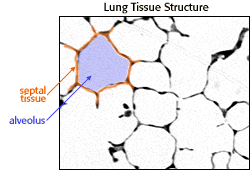|
The Mathematics of MorphometricsCenter for Toxicology
In the Environmental Tobacco Smoke Activity, student use morphometry
to study the effects The morphometric mathematical data analysis technique was originally developed by geologists who needed a method for measuring the volume of minerals in rocks. Morphometry was later adapted by a Swiss scientist, Dr. Ewald Weibel, and applied to microscopic images of body tissues and/or cells.
In the Environmental Tobacco Smoke (ETS) activity, lung tissue is
prepared for viewing under a microscope.

Next, the image is electronically captured using a digital camera. The image can be analyzed using image-processing software or by hand, Mathematics play an extremely important role in toxicological studies such as this one because sophisticated mathematics, including theorems from statistical geometry, are used to prove that using sampling of a limited number of animals can still allow scientists to get good,valid data. For further information on morphometric analysis of ETS effects on developing lung tissue, follow this link to the Biology Project activity, "Environmental Tobacco Smoke and Lung Development."
|
 of environmental tobacco smoke (second-hand
smoke) on lung development. Morphometry is a mathematical data
analysis technique. Morphometry allows scientists to use a number of
samples from different experimental groups to study the two- and
three-dimensional structures present in the samples.
of environmental tobacco smoke (second-hand
smoke) on lung development. Morphometry is a mathematical data
analysis technique. Morphometry allows scientists to use a number of
samples from different experimental groups to study the two- and
three-dimensional structures present in the samples.
 using a morphometric technique called "point counting."In the ETS activity, pointing counting allows scientists/students to look at samples of lung tissues on microscope slides and estimate three-dimensional data (such as lung air space volume or alveolar volume) by counting the two-dimensional data on the tissue slides. The three-dimensional data is then used to infer affects of ETS on gas exchange in the lungs.
using a morphometric technique called "point counting."In the ETS activity, pointing counting allows scientists/students to look at samples of lung tissues on microscope slides and estimate three-dimensional data (such as lung air space volume or alveolar volume) by counting the two-dimensional data on the tissue slides. The three-dimensional data is then used to infer affects of ETS on gas exchange in the lungs.